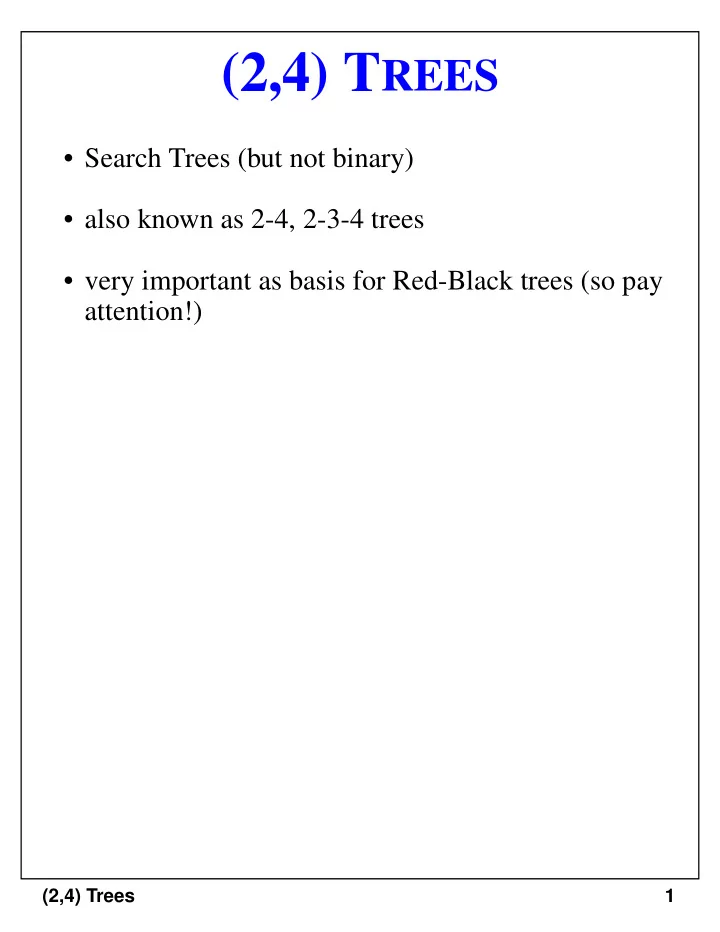

(2,4) T REES • Search Trees (but not binary) • also known as 2-4, 2-3-4 trees • very important as basis for Red-Black trees (so pay attention!) (2,4) Trees 1
Multi-way Search Trees • Each internal node of a multi-way search tree T : - has at least two children - stores a collection of items of the form ( k , x ), where k is a key and x is an element - contains d - 1 items, where d is the number of children ∞ ∞ - “contains” 2 pseudo-items: k 0 = – , k d = • Children of each internal node are “between” items - all keys in the subtree rooted at the child fall between keys of those items • External nodes are just placeholders (2,4) Trees 2
Multi-way Searching • Similar to binary searching < • If search key s k 1 , search the leftmost child > • If s k d , search the rightmost child – 1 > • That’s it in a binary tree; what about if d 2 ? • Find two keys k i and k i between which s falls, – 1 and search the child v i . Searching 22 for s = 8 Searching for s = 12 5 10 25 27 3 4 6 8 14 23 24 11 13 17 18 19 20 21 Not found! • What would an in-order traversal look like? (2,4) Trees 3
(2,4) Trees • At most 4 children • All external nodes have same depth ( ) • Height h of (2,4) tree is O log n . • How is this fact useful in searching? 12 5 10 15 11 17 3 4 6 8 13 14 (2,4) Trees 4
(2,4) Insertion • Always maintain depth condition • Add elements only to existing nodes Insert 4 Insert 6 Empty 4 6 4 tree Insert 12 Insert 15 ? 4 6 12 • What if that makes a node too big? - overflow • Must perform a split operation - replace node v with two nodes v ' and v '' - v ' gets the first two keys - v '' gets the last key - send the other key up the tree - if v is root, create new root with third key - otherwise just add third key to parent • Much clearer with a few pictures... (2,4) Trees 5
(2,4) Insertion (cont.) Insert 15 12 12 4 6 12 15 4 6 15 4 6 15 Insert 3 12 12 Insert 5 3 15 5 15 4 6 3 4 6 12 5 12 5 15 3 4 6 3 4 6 15 • Tree always grows from the top, maintaining balance • What if parent is full? (2,4) Trees 6
(2,4) Insertion (cont.) • Do the same thing: Insert 17 5 10 12 3 4 6 8 11 13 14 15 17 5 10 12 15 3 4 6 8 11 13 14 17 12 5 10 15 3 4 6 8 11 13 14 17 • Overflow cascade all the way up to the root ( ) - still at most O log n (2,4) Trees 7
(2,4) Deletion • A little trickier • First of all, find the key - simple multi-way search • Then, reduce to the case where deletable item is at the bottom of the tree - Find item which precedes it in in-order traversal - Swap them • Remove the item Delete 13 11 6 15 13 17 5 8 10 14 • Easy, right? • ...but what about removing from 2-nodes? (2,4) Trees 8
(2,4) Deletion (cont.) • Not enough items in the node - underflow • Pull an item from the parent, replace it with an item from a sibling - called transfer 5 10 Delete 4 4 6 8 11 u 10 5 6 v w 11 8 • Still not good enough! What happens if siblings are 2-nodes? • Could we just pull one item from the parent? - too many children • But maybe... (2,4) Trees 9
(2,4) Deletion (cont.) • We know that the node’s sibling is just a 2-node • So we fuse them into one - after stealing an item from the parent, of course Delete 12 6 10 12 8 5 u 6 10 v 8 5 u 6 5 8 10 • Last special case, I promise: what if the parent was a 2-node? (2,4) Trees 10
(2,4) Deletion (cont.) • Underflow can cascade up the tree, too. Delete 14 11 15 6 14 5 8 10 17 11 u 6 15 v 17 5 8 10 11 u 6 5 8 10 15 17 6 11 5 8 10 15 17 (2,4) Trees 11
(2,4) Conclusion ( ) • The height of a (2,4) tree is O log n . ( ) • Split, transfer, and fusion each take O 1 . ( ) • Search, insertion and deletion each take O log n . • Why are we doing this? - (2,4) trees are fun! Why else would we do it? - Well, there’s another reason, too. - They’re pretty fundamental to the idea of Red-Black trees as well. - And you’re covering Red-Black trees on Monday. - Perhaps more importantly, your next project is a Red-Black tree. • Have a nice weekend! (2,4) Trees 12
Recommend
More recommend